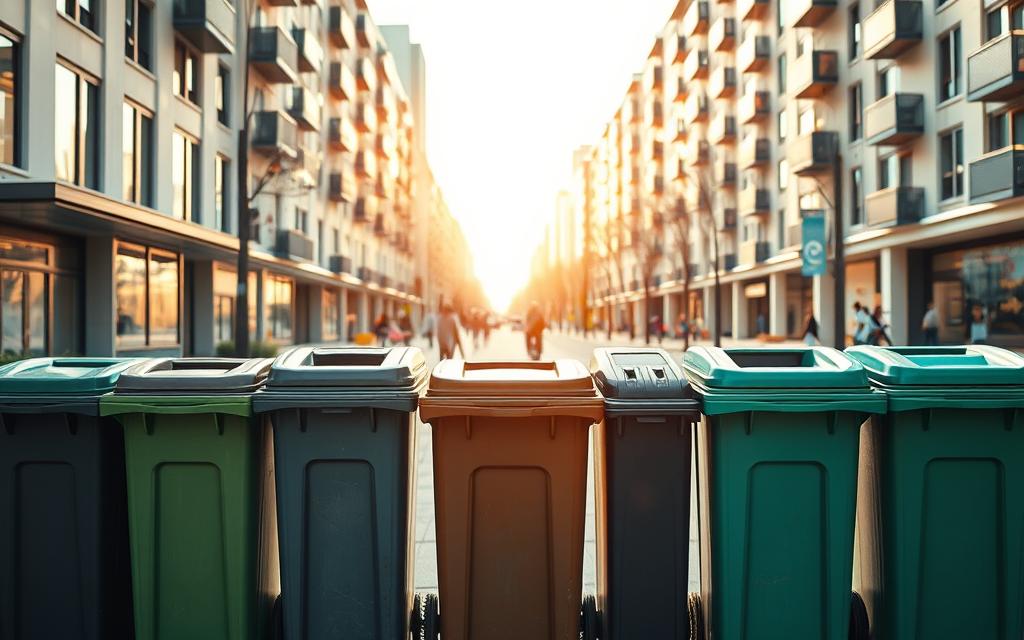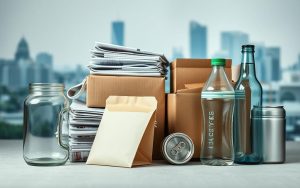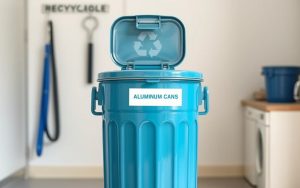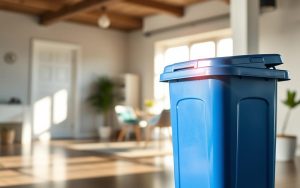Table of Contents
Effective waste management starts with having the right tools. Functional containers play a crucial role in modern systems, ensuring materials are sorted and processed efficiently. Over time, wear and tear can make replacements necessary, whether due to damage, loss, or upgrades.
Many municipalities offer programs to repair or replace containers. These initiatives help households maintain proper waste disposal practices. Regular maintenance, such as cleaning and inspecting containers, can extend their lifespan and improve usability.
Proper recycling reduces landfill waste and supports environmental sustainability. Functional containers are essential for achieving these goals. This article will guide you through the process of obtaining replacements and highlight the benefits of maintaining an organized waste system.
Why You Might Need New Recycling Bins
Maintaining an efficient waste system often requires updating your tools. Over time, containers can deteriorate due to weather exposure and UV damage. This physical wear can compromise their functionality, making replacements necessary.
Broken mechanisms, such as lids, wheels, or hinges, can render a container unusable. Household size changes may also lead to capacity issues, requiring larger or additional containers. Compliance with updated municipal guidelines is another reason to consider replacements.
Pest damage or structural weaknesses can pose safety hazards, such as sharp edges. Specialized needs, like multi-stream systems, may also require specific types of containers. Damaged bins can negatively impact community cleanliness and recycling efforts.
Repairing or replacing containers is often more cost-effective than dealing with the consequences of ineffective waste management. Solid Waste Management programs often repair damaged carts at no cost, ensuring residents have functional tools for proper disposal.
In Connecticut, everyone is required to recycle, including businesses and households. For more information on local recycling programs, visit the Connecticut Recycling Program FAQ.
Environmental benefits, such as energy savings and reduced pollution, depend on effective recycling practices. Ensuring your containers are in good condition supports these goals and promotes sustainability.
How Do I Get New Recycling Bins?
Replacing worn-out containers ensures efficient waste disposal. Functional tools are essential for maintaining an organized system. This section outlines the steps to obtain replacements and keep your waste management process smooth.
Step 1: Assess the Condition of Your Current Bins
Start by evaluating the state of your current container. Look for cracks, broken lids, or other damages. A detailed inspection helps determine if a replacement is necessary.
Check for structural weaknesses or pest damage. Ensure the container meets your household’s capacity needs. Proper evaluation saves time and resources.
Step 2: Contact Your Local Waste Management Service
Reach out to your municipal service provider. Most cities offer dedicated channels for replacement requests. Options include phone calls, online portals, or mobile apps.
For example, you can call 311 Customer Service at 3-1-1 or 210-207-6000. Many services also provide multi-language support for convenience.
Step 3: Provide Necessary Information
Prepare required documentation, such as proof of residence and service history. This ensures a smooth request process. Be ready to share details about the condition of your container.
Ask about timelines and cost structures. Some municipalities offer free replacements, while others may charge a fee. Special provisions are often available for elderly or disabled residents.

| Contact Method | Details | Timeline |
|---|---|---|
| Phone | Call 311 or local service number | 1-3 business days |
| Online Portal | Submit a request via municipal website | 3-5 business days |
| Mobile App | Use the official waste management app | 2-4 business days |
Understanding the Repair and Replacement Process
Understanding the repair and replacement process ensures your waste system remains efficient. Municipal service providers often prioritize repairs to extend the lifespan of containers. This approach reduces waste and supports sustainability.
Damaged containers are assessed within five working days. Staff evaluate the extent of damage, such as cracks or broken lids, to determine if repairs are feasible. Temporary solutions are provided during repair periods to maintain uninterrupted service.
Replacement criteria are strict. Containers are only replaced if they are irreparable or pose safety risks. Replacement units are made from durable plastic materials, ensuring longevity and reliability.
The repair-first approach has significant environmental benefits. It reduces the need for new materials and minimizes landfill contributions. Municipal programs also track service requests to ensure timely resolutions.
Quality standards for replacement containers are high. They must meet durability and capacity requirements. Warranty information is provided, offering peace of mind to residents.
Cost-saving benefits are a key advantage of municipal programs. Repairs are often free, while replacements may incur minimal fees. Special provisions are available for elderly or disabled residents.
Common reasons for repair denial include misuse or contamination. Proper use and maintenance prevent such issues. Recycling contamination prevention measures are emphasized to maintain system efficiency.
| Process Step | Details | Timeline |
|---|---|---|
| Damage Assessment | Staff evaluate the condition of the container | 5 working days |
| Repair Approval | Repairs are approved if feasible | 1-2 business days |
| Replacement Criteria | Irreparable or unsafe containers are replaced | 3-5 business days |
What to Do If Your Bin Is Damaged
Addressing damage to your waste container promptly ensures safety and efficiency. Damaged containers can lead to leaks, pest infestations, or even injuries. Taking immediate action helps maintain a clean and functional waste system.
For hazardous damage, such as sharp edges or biohazard contamination, follow emergency procedures. Contact your local waste management service immediately. They can provide guidance on safe handling and temporary solutions.
Proper documentation is essential for insurance claims or municipal assistance. Take clear photos of the damage and note the date and time. This information supports your request for repair or replacement.
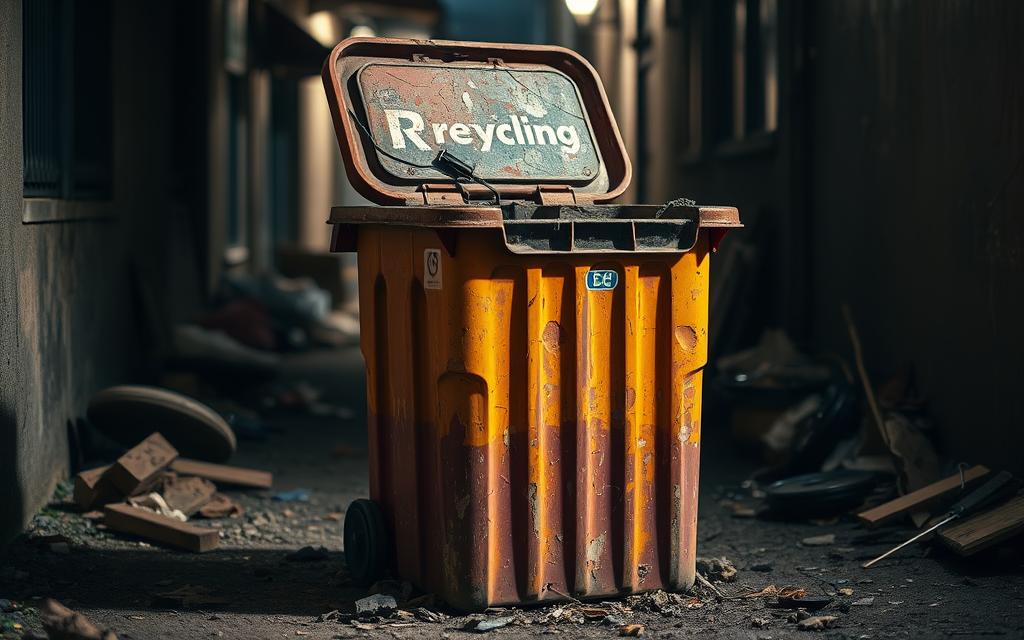
Temporary storage solutions for recyclables include using alternative containers or bags. Ensure these are clearly labeled to avoid confusion with regular trash. This prevents contamination and keeps your recycling efforts on track.
Prevention strategies can minimize future damage. Regular cleaning and inspections help identify issues early. Avoid overloading the container, as this can strain the lid and hinges.
“Container must be empty when requesting repair.”
Municipal liability guidelines vary by location. Some cities cover repair costs, while others may require residents to pay. Check local regulations to understand your responsibilities.
Weather-related damage can be mitigated by storing containers in sheltered areas. Use covers to protect against rain, snow, and UV exposure. This extends the lifespan of plastic containers.
Vandalism should be reported to local authorities immediately. Provide details such as the time, location, and nature of the damage. Many municipalities have dedicated channels for such incidents.
Special handling is required for biohazard contamination. Avoid direct contact and use protective gear. Contact professionals for safe removal and disposal.
Barcode or RFID tracking systems help monitor container usage and damage. These technologies streamline the repair process and ensure timely resolutions.
Interactive damage assessment tools are available in some areas. These online platforms allow residents to submit photos and descriptions of damage. They provide instant feedback on repair options.
| Emergency Procedure | Reporting Protocol | Timeline |
|---|---|---|
| Hazardous Damage | Contact local waste management | Immediate |
| Vandalism | Report to local authorities | Within 24 hours |
| Biohazard Contamination | Contact professionals | Immediate |
Tips for Maintaining Your Recycling Bins
Keeping your waste containers in top shape ensures a cleaner home and environment. Regular maintenance not only extends their lifespan but also improves efficiency. Here are practical tips to help you care for your containers.
Establish a cleaning schedule using approved disinfectants. This prevents buildup and keeps odors at bay. For moving parts like lids and hinges, apply lubrication techniques to ensure smooth operation.
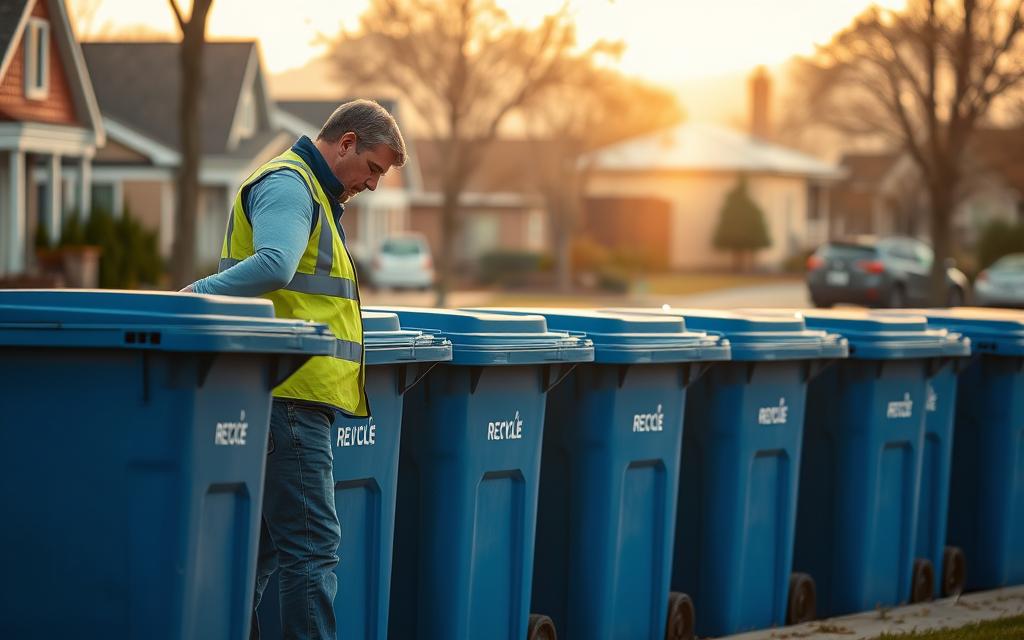
Protect plastic products from UV damage by storing them in shaded areas. Use covers to shield against harsh weather conditions. Proper weight distribution prevents strain on the container’s structure.
Odor control solutions, such as baking soda or specialized sprays, keep your recycling area fresh. Theft prevention strategies, like labeling and secure storage, safeguard your investment.
In colder climates, winterization techniques are essential. Use insulated covers to prevent cracking. For households with multiple bins, organizational systems streamline the sorting process.
Child safety considerations include locking mechanisms to prevent access. Compliance with HOA regulations ensures your setup meets community standards. These steps help maintain an efficient and safe waste management system.
Common Questions About Recycling Bin Requests
Navigating the process of obtaining replacement containers often raises questions about policies and procedures. Understanding these details ensures a smooth experience. Below are answers to frequently asked questions.
Cost clarification for different service tiers is a common concern. Most municipalities offer free replacements for basic containers. However, larger or specialized units may incur additional fees. Always check with your local service provider for specific pricing.
Multi-family housing regulations vary by location. Some areas require individual containers for each unit, while others provide shared bins. Ensure compliance with local guidelines to avoid penalties.
Commercial and residential bins differ in size and design. Businesses often require larger containers to handle higher waste volumes. Specialized options, like those for medical waste, are also available.
Bilingual support is increasingly common. Many providers offer assistance in multiple languages to accommodate diverse communities. Check availability when contacting your local service.
Specialized medical waste exceptions require specific containers. These are often provided by licensed waste management companies. Ensure proper disposal to comply with health and safety regulations.
Holiday schedule adjustments may affect pickup times. Most services operate seven days a week from 7am-7pm, but holidays can alter this. Confirm schedules in advance to avoid disruptions.
Container customization options are available in some areas. These include color-coded bins for easier sorting or personalized labels. Customization can enhance efficiency and compliance.
Disposal procedures for old bins vary. Some municipalities collect and recycle them, while others require residents to drop them off at designated locations. Proper disposal ensures environmental responsibility.
Data privacy protections are in place for all service requests. Personal information is securely handled to prevent misuse. Always verify the privacy policies of your provider.
Dispute resolution processes are available for unresolved issues. Most providers have dedicated teams to address complaints and ensure customer satisfaction. Keep records of all communications for reference.
How to Choose the Right Recycling Bin for Your Needs
Selecting the right waste management tools can significantly enhance your daily routine. The right product ensures efficiency, durability, and ease of use. Start by assessing your household size to determine the ideal capacity for your containers.
Material choice plays a crucial role in longevity. Plastic bins are lightweight and weather-resistant, while metal options offer sturdiness. Composite materials provide a balance of durability and aesthetics. Consider your environment when making this decision.
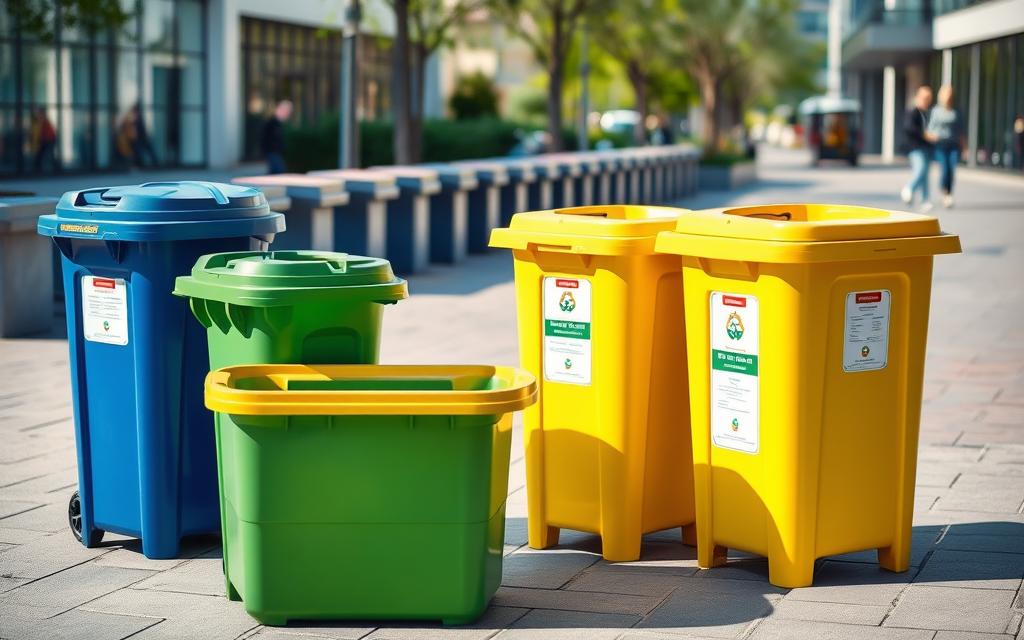
Security features are essential for urban settings. Look for lockable lids to prevent tampering or theft. ADA-compliant designs ensure accessibility for all users, making waste management inclusive and convenient.
Smart bin technology is revolutionizing waste management. Mobile app-connected models allow you to monitor fill levels and schedule pickups. These innovations streamline the process and reduce manual effort.
Brand comparisons can help you find the best fit. Simplehuman offers sleek designs, while Rubbermaid focuses on durability. Home Depot provides budget-friendly options without compromising quality.
Space-saving stackable systems are ideal for smaller homes. These designs maximize storage while maintaining organization. Color-coding standards simplify the sorting process, ensuring compliance with waste stream guidelines.
Premium features like odor control and built-in liners add convenience. Conduct a cost-benefit analysis to determine if these extras align with your needs. Investing in the right product can save time and money in the long run.
Conclusion
Proper waste management relies on efficient tools and community effort. Maintaining functional containers ensures materials are sorted and processed effectively, reducing environmental impact. This content has outlined the steps to request replacements and emphasized the importance of regular maintenance.
Communities play a vital role in promoting sustainability. By adopting modern products and technologies, we can enhance our recycling systems. Future trends, like smart bins and advanced sorting methods, promise even greater efficiency.
For local services, consult your municipal website or contact customer support. Together, we can build a cleaner, greener future. Take action today and contribute to a sustainable environment.
FAQ
What steps are involved in requesting a replacement recycling container?
Start by evaluating the condition of your current bin. Next, reach out to your local waste management service. Finally, provide the required details for processing your request.
How can I determine if my recycling bin needs repair or replacement?
Inspect the bin for cracks, broken lids, or other damage that affects functionality. If repairs aren’t feasible, contact your waste collection provider for a replacement.
What information is needed when ordering a new recycling bin?
Typically, you’ll need to provide your address, account details, and a description of the issue with your current container. Some services may also require proof of residency.
Are there specific guidelines for maintaining recycling bins?
Regularly clean your bin to prevent odors and contamination. Avoid overfilling it, and ensure the lid is securely closed to prevent spills during collection.
What should I do if my recycling bin is damaged?
Report the damage to your local waste management service immediately. They will guide you on whether it can be repaired or if a replacement is necessary.
How do I choose the right recycling bin for my household?
Consider the size of your household and the volume of recyclables you generate. Check with your local service for approved container types and sizes.
Is there a cost associated with replacing a recycling bin?
Costs vary by location and service provider. Some municipalities offer free replacements, while others may charge a fee. Contact your local service for details.


